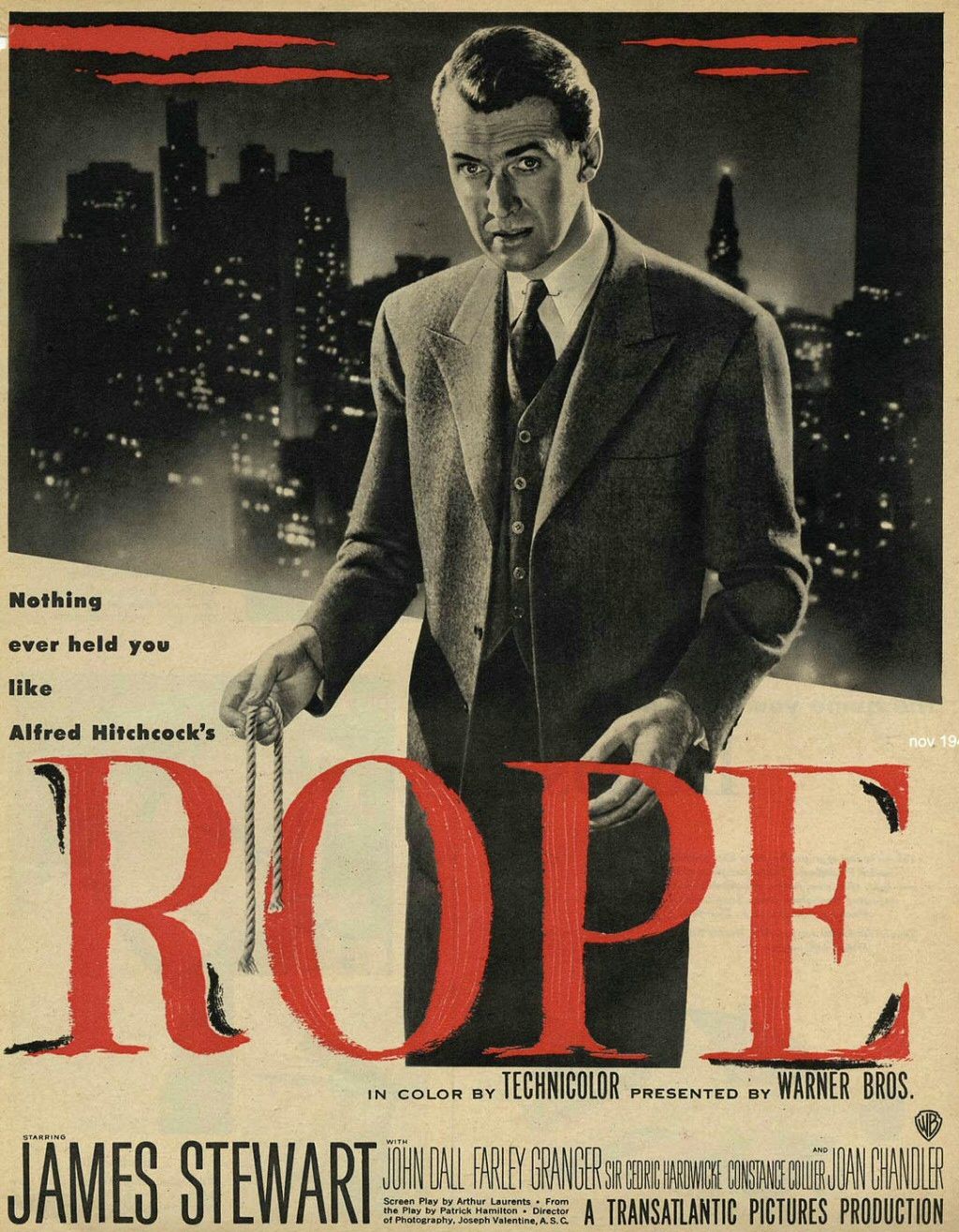The DECODER series — to which SEMIOVOX has invited our semiotician colleagues from around the world to contribute — explores fictional semiotician-esque action as depicted in books, movies, TV shows, etc.
Via minimal scene cuts and innovations in how time, space, and lighting are handled, with the 1948 psychological crime thriller Rope, Alfred Hitchcock aimed to replicate a theatrical experience. We are confined in a Manhattan penthouse apartment, where within the first few minutes of the movie two arrogant young aesthetes, Brandon (John Dall) and Phillip (Farley Granger), have strangled to death a former prep-school classmate, David (Dick Hogan). The lifeless body is stowed away in a chest. There is no suspense, here — we know who was murdered, how he was murdered, and by whom. The end?
No! The party is just beginning — literally, as Brandon and Phillip host a dinner party that same evening. The chest containing the body is used as a buffet. One of the guests at the party, Rupert Cadell (James Stewart), a theory-driven intellectual, was once Brandon and Phillip’s prep-school housemaster.
In the movie’s mise en scène, objects play a central role. Books, gloves, crystal glasses, curtains, candelabras, cigarette cases, armchairs, a piano, a metronome, a gun, a rope, a gray fedora… and of course, the chest/buffet. Hitchcock’s camera shifts back and forth perpetually, ensuring that we never grow bored of being trapped in a single location; via the camera’s movements, the various objects communicate meaning to us — as they do to Cadell. This is the movie’s first lesson for semioticians: Pay close attention to objects, to material culture generally, as there’s more to learn than we might imagine.
The movie’s dialogues express meaning not through denotative logic but by employing metaphors, analogies, ironies, and other double meanings. These figures of speech draw Cadell (and us) into the killers’ cat-and-mouse game. While the party’s other guests are baffled by Bandon and Phillip’s speech, Cadell enjoys it; although eventually he’ll become the decoder who reveals the truth, in fact he tends to prefer allusive communications to “straight talk.” We discover that it was Cadell who introduced the young men to the Nietzschean idea of the beyond-good-and-evil “superman” that inspired David’s murder. Our second lesson, then, is this: Theory and practice can be worlds apart.
Rope is the first of Hitchcock’s Technicolor films (Natalie Kalmus is the movie’s Technicolor color director), and although audiences had learned to associated crime thrillers — “Noir” — with black-and-white, in the movie’s closing scenes color is deployed skillfully. A flashing neon sign bathes the scene in shades of green and red, amplifying the growing tension among Cadell, Brandon, and Phillip. Hitchcock, one of the great applied semioticians, is honing his skills, here, using colors to evoke intense emotions — a tactic he’d employ masterfully a decade later in Vertigo, which I consider to be his masterpiece. Our final lesson, then, is this: Colors always mean something. But what?
There is more to say about the movie, particularly around how it handles sexuality and class. (Dario Martinelli’s The Intertextual Knot: An Analysis of Alfred Hitchcock’s Rope and David Green’s “Making a Meal of Manhood: Rope, Orality, and Queer Anguish” are highly recommended, for further reading.) But hopefully I’ve persuaded you that although it isn’t Hitchcock’s most renowned work, Rope offers us a fascinating 80-minute “laboratory” in decoding.
DECODER: Adelina Vaca (Mexico) on ARRIVAL | William Liu (China) on A.I. ARTIFICIAL INTELLIGENCE | Tim Spencer (England) on VURT | Ramona Lyons (USA) on BABEL-17 | Rachel Lawes (England) on NICE WORK | Alfredo Troncoso (Mexico) on THE ODYSSEY | Gabriela Pedranti (Spain) on MUSIC BOX | Charles Leech (Canada) on PATTERN RECOGNITION | Lucia Laurent-Neva (England) on LESSONS IN CHEMISTRY | Whitney Dunlap-Fowler (USA) on THE GIVER | Colette Sensier (England / Portugal) on PRIESTDADDY | Jamin Pelkey (Canada) on THE WONDER | Maciej Biedziński (Poland) on KOSMOS | Josh Glenn (USA) on LE GARAGE HERMÉTIQUE | Antje Weißenborn (Germany) on BABYLON BERLIN | Ximena Tobi (Argentina) on SIX FEET UNDER | Mariane Cara (Brazil) on ROPE | Maria Papanthymou (Greece) on MY FAMILY AND OTHER ANIMALS | Chirag Mediratta (India) on BLEACH | Dimitar Trendafilov (Bulgaria) on THE MATRIX | Martha Arango (Sweden) on ONE HUNDRED YEARS OF SOLITUDE | Becks Collins (England) on THE HITCHHIKER’S GUIDE TO THE GALAXY | Ivan Islas (Mexico) on THE NAME OF THE ROSE | Paulina Goch-Kenawy (Poland) on THE SENSE OF AN ENDING | Eugene Gorny (Thailand) on SHUTTER ISLAND & FRACTURED.
Also see these international semio series: COVID CODES | SEMIO OBJECTS | MAKING SENSE | COLOR CODEX | DECODER


